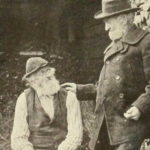We run our website the way we wished the whole internet worked: we provide high quality original content with no ads. We are funded solely by your direct support. Please consider supporting this project.
How NOT to be Christ-Centered: A Review of God With Us – Part III
In the previous two posts on Oliphint’s God With Us, we’ve seen that Oliphint is trying to reframe divine accommodations in a Christ-centered way, but that what he means by this is not that he is going to derive his understanding of God from Christ, but that he is going to use the “hypostatic union” articulated at the Council of Chalcedon as his framework.
Oliphint is admirably forthright in acknowledging the paradoxical nature of the Chalcedonian Christology, as he interprets it. In becoming human while retaining all of God’s essential properties, Oliphint admits that, “the Son of God partakes of two different and seemingly incommensurable kinds of properties” (206). So too, when God became a human while retaining all his essential attributes, he created an “antiomic situation” that inevitable results in “a paradox.” Hence, “any proper attempt at explaining that union will result in paradox” (209).
Indeed, Oliphint several times seems to concede that this Christology is – or at least inevitably appears to be –blatantly contradictory. For example, Oliphint at one point concedes the objection of Thomas Morris concerning the contradictory properties ascribed to one person in the Chalcedonian confession.
That two contradictory properties can reside in one person does not thereby remove the contradiction…just because the two are one does not automatically mean that we can articulate that ”oneness” in an intellectually satisfying way. Thus, because it is one person who has these conflicting properties, it makes it difficult for us to describe his character without quickly reaching our intellectual boundaries (205).
Not only does Oliphint concede that this interpretation of the Chalcedonian Christology is apparently contradictory, but his central strategy for understanding divine accommodations involves turning this “antinomic situation” to his advantage. He does this by using this mysterious hypostatic union as the paradigm for understanding how a wholly independent, atemporal, immutable and impassible God can appear so different in Scripture. Indeed, this is precisely what Oliphint means when he claims to have a Christ-centered understanding of accommodation. “[T]he Chaleconian Creed,” he says, “gives us substantial and significant precedent in which we can accept and affirm that there is a mysterious harmony in [God’s] attributes” as he condescends to interact with his people (205).
Hence, just as God condescended in Christ to take on human attributes without setting aside his essential divine attributes, so too God has throughout history condescended to take on the attributes of his creation as a means of relating to, and revealing himself to, his people. Oliphint essentially applies the “reduplicating strategy” (“X as A is N”), mentioned in Part I, to the whole Bible. As God is in himself, God is wholly independent, pure act, immutable, impassible, etc. As God is in his covenantal activity, however, God can be responsive, change his mind, be influenced by others, experience passions and even acquire information over time (192-94 ).
And here’s where things begin to get interesting (finally, some may be thinking). The most important implication of Oliphint’s Chalcedonian reframing of God’s condescending activity is that it allows him to affirm that the “covenantal attributes” that God acquires as he condescends to relate to humans are real – as real as the humanity that God assumed in Christ. “[God] both is immutable and in his condescension takes on covenantal properties in order really and truly to relate himself to us.” (191). This means that Oliphint doesn’t have to explain passages that depict God experiencing emotion, changing his mind or acquiring information through time by saying they are merely anthropomorphic or phenomenological descriptions, as the classical tradition has typically done. Indeed, Oliphint sides with Open Theists who have, in his view, effectively exposed the weakness of these explanations (183-94, 219-19).
Oliphint rather argues that, “God really does take these properties” (219). Hence, God literally changes his mind (op.cit.) “[T]he God who is immutable and whose plan and purposes for creation and his people will not fail can and does relent” (186). In his view, any explanation of these depictions of God that denies their literal reality “fails to recognize that what God has done in Christ through condescension he has been doing from the dawn of time” (191-92). As God literally became a human in Christ while retaining his essential properties, so too God literally takes on all the properties ascribed to him in Scripture as he condescends to relate to his people.
If one questions how a God who cannot be affected by anything outside himself can nevertheless really be affected by things outside himself and can really be responsive, or if one wonders how a God who is pure act and thus has no potential for change can nevertheless really become something he was not before (the Incarnation) and can nevertheless really change his mind, Oliphint simply points them back to the mystery of the (his interpretation of) the Chalcedonian Christology. In the end, Oliphint concedes that this conception of God is “shrouded in mystery” (226) as he encourages us to “get used to the idea that antimony and paradox will inevitably surround discussions such as this…” (225).
So, what should we make of all this? I will offer my response in the fourth and final segment of this review.
Category: Essays
Tags: Book Reviews, Classical Theism, Cruciform Theology, Essay, God With Us
Topics: Biblical Interpretation
Related Reading

Podcast: Is Cruciform Hermeneutics Simply Midrash?
Greg considers whether Cruciform Hermeneutics is just a complicated way of seeing what I want to see in the text, and offers nuanced thought for our more complicated hermeneutical challenges. http://traffic.libsyn.com/askgregboyd/Episode_0307.mp3

The Cross Above All Else
The way to know what a person or people group really believes is not to ask them but to watch them. Christians frequently say, “It’s all about Jesus,” but our actions betray us. Judging by the amount of time, energy, and emotion that many put into fighting a multitude of battles, ranging from the defense…

Podcast: Doesn’t Claiming that the Old Testament Writers were Sometimes Wrong Inevitably Lead to a Slippery Slope?
Greg talks about cataphatic prayer and the role of the imagination. http://traffic.libsyn.com/askgregboyd/Episode_0470.mp3

Part 9 (of 15): Peterson on White Privilege
Assessing Jordan Peterson’s 12 Rules for Life by Greg Boyd “The degree to which the terrible part of the world manifests itself in your life is proportionate to how insufficient you are….If you got your act together completely, maybe all the suffering would disappear from your life, or at least all the unbearable suffering.” Jordan…

Podcast: If the Biblical Prophecies are Flawed, Aren’t Those Prophets ALL False Prophets?
If you want to hear Greg sweat, listen to him work through this really really good question. http://traffic.libsyn.com/askgregboyd/Episode_0200.mp3 Photo by Rex Boggs

Podcast: Where Does Forgiveness Fit in a Cruciform Theology?
Greg offers looks at forgiveness in a realm of natural consequences. http://traffic.libsyn.com/askgregboyd/Episode_0298.mp3

